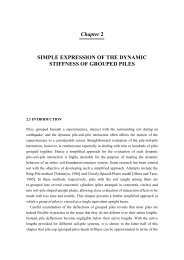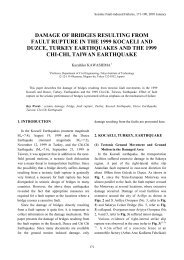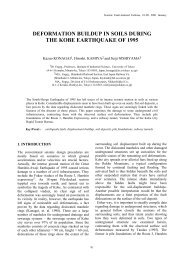Damage to ShihKang Dam Inflicted by Faulting in the Sept. 1999 Chi ...
Damage to ShihKang Dam Inflicted by Faulting in the Sept. 1999 Chi ...
Damage to ShihKang Dam Inflicted by Faulting in the Sept. 1999 Chi ...
You also want an ePaper? Increase the reach of your titles
YUMPU automatically turns print PDFs into web optimized ePapers that Google loves.
Horizontal maximum acceleration (gal)<br />
<br />
<br />
<br />
Soil-based ground<br />
Foundation rock of dam site<br />
<br />
Epicentral distance (km)<br />
Figure 8 Attenuation of acceleration<br />
ß<br />
Figure 7 Observed peak values of orthogonal<br />
components of accelerations (NS, EW, UD)<br />
(Central Wea<strong>the</strong>r Bureau, Taiwan)<br />
Figure 9 Ta-<strong>Chi</strong>a River<br />
<br />
UD directions were reached. When <strong>the</strong> dynamic<br />
stability of dam is discussed, evaluation of <strong>the</strong><br />
attenuation of base rock motion with respect <strong>to</strong> <strong>the</strong><br />
distance is certa<strong>in</strong>ly a key issue. S<strong>in</strong>ce no<br />
seismometer was <strong>in</strong>stalled <strong>in</strong> <strong>the</strong> Shih-Kang <strong>Dam</strong>,<br />
<strong>the</strong> obta<strong>in</strong>ed accelerations will be of some help for<br />
us <strong>to</strong> go on <strong>to</strong> fur<strong>the</strong>r detailed discussions. Figure 8<br />
shows <strong>the</strong> peak values of acceleration observed on<br />
both rock outcrops and soil sediments <strong>to</strong>ge<strong>the</strong>r with<br />
those observed <strong>in</strong> <strong>the</strong> 1995 Kobe Earthquake; <strong>the</strong><br />
accelerations are plotted with respect <strong>to</strong> <strong>the</strong> distance<br />
from <strong>the</strong> nearest fault rupture plane. Among <strong>the</strong><br />
accelerations recorded <strong>in</strong> <strong>the</strong> <strong>Chi</strong><strong>Chi</strong> earthquake, <strong>the</strong><br />
peak value of 277 cm/s 2 was reached at <strong>the</strong> WuSheh<br />
dam; <strong>the</strong> peak absolute value of <strong>the</strong> resultant vec<strong>to</strong>r<br />
of <strong>the</strong> three orthogonal components. It is an<br />
empirical f<strong>in</strong>d<strong>in</strong>g, through long-term earthquake<br />
observations, that <strong>the</strong> maximum value of a resultant<br />
vec<strong>to</strong>r is often about 1.4 times as large as that of<br />
ei<strong>the</strong>r lateral component. Therefore, <strong>the</strong> peak value<br />
of one horizontal acceleration component is<br />
estimated <strong>to</strong> have reached about 194 cm/s 2 . The<br />
outcrop accelerations observed <strong>in</strong> <strong>the</strong> <strong>Chi</strong><strong>Chi</strong><br />
earthquake, when plotted on this figure, seem <strong>to</strong> fall<br />
<strong>in</strong> <strong>the</strong> possible range of scatter<strong>in</strong>g.<br />
3 DAMAGE TO SHIHKANG DAM<br />
3.1 General view<br />
Shih-Kang <strong>Dam</strong> was built across <strong>the</strong> Ta-<strong>Chi</strong>a river<br />
where <strong>the</strong> river’s fan-shaped pla<strong>in</strong> beg<strong>in</strong>s <strong>to</strong> spread<br />
gradually <strong>to</strong>wards <strong>the</strong> East Ch<strong>in</strong>a Sea (Figure 9).<br />
The dam site lies over a shallow sandy and gravelly<br />
soil deposit spread<strong>in</strong>g over a lam<strong>in</strong>ated mass of mud<br />
s<strong>to</strong>ne, silt s<strong>to</strong>ne and sand s<strong>to</strong>ne of <strong>the</strong> Pliocene<br />
Epoch, Tertiary Period. The construction of <strong>the</strong> dam<br />
began with <strong>the</strong> excavation of this shallow sandy and<br />
gravelly soil deposit down <strong>to</strong> <strong>the</strong> underly<strong>in</strong>g rock<br />
surface, and was completed <strong>in</strong> 1977.<br />
The Shih-Kang <strong>Dam</strong>, 25 m tall and 357 m long<br />
with 18 gates l<strong>in</strong>ed up, has a <strong>to</strong>tal concrete bulk of<br />
141,300 m 3 (Figure 10 “Plan”, “Elevation” and<br />
“general spillway cross-section”). The reservoir<br />
with a capacity of 3.38 million m 3 collects water<br />
from a catchment area of 1,061 km 2 <strong>in</strong> <strong>the</strong><br />
Chung-Yang Mounta<strong>in</strong>s, and provides a steady<br />
supply of water for irrigation, and etc. An <strong>in</strong>take<br />
tunnel on <strong>the</strong> left abutment of <strong>the</strong> dam leads <strong>the</strong><br />
water through a diluvial terrace down <strong>to</strong> <strong>the</strong><br />
Feng-Yuan water-treatment plant.<br />
146






